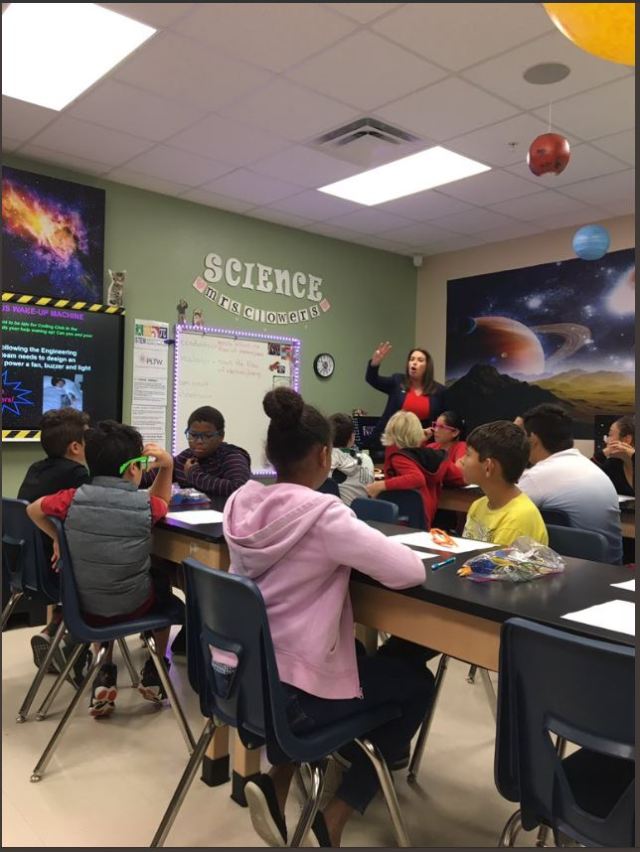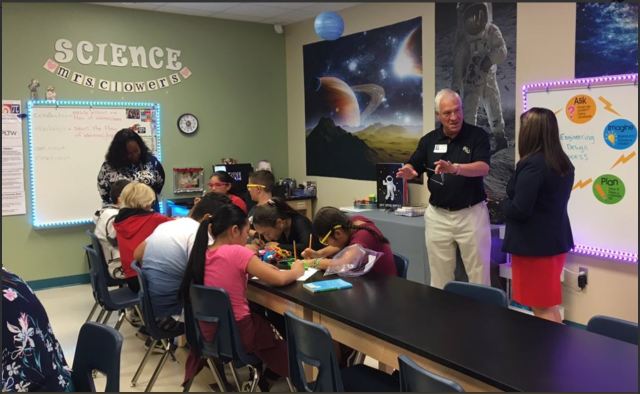
Dream Lake Elementary School’s Lanie Clowers leads her amazing 5th grade science class (photo by Bonnie Toffoli)
Every 5th grader who was in Lanie Clowers’s classroom at Apopka’s Dream Lake Elementary School when I visited today understood the nature of electric current and that electrons can flow through a circuit only if it is closed. They demonstrated that by building working circuits involving batteries, wires, incandescent bulbs, buzzers and fans.
In contrast, when I start my second semester calculus-based introductory physics course for engineers and physical scientists, only about half the students understand that a circuit has to be closed to operate an electrical device.
There were other things about the 5th grade class I visited today that were worth seeing: the light show and procession of students as class started; the remarkable energy of Mrs. Clowers, who was the 2016 Orange County Public Schools Teacher of the Year; and the support of the school and district administration for the work being done in that classroom.
But for me, the highlight of the classroom visit was the moment I realized that Mrs. Clowers’s 5th graders really and truly understood electric current and circuits.
I told Mrs. Clowers during the class that if she enrolled her 5th graders in my college course at FSU in January that they could skip the first two weeks of the semester because they already knew what my students would be learning during that time period.
And if you think that my students have problems with the basics of circuits because they are at FSU, check out this video of new MIT engineering graduates trying to light a bulb with a battery and wire. They don’t get the basics, either. And it limits their innovation potential.
Meanwhile, Mrs. Clowers’s 5th graders have already cleared that hurdle.
The big challenge that became apparent to me as I watched the remarkable classroom scene today was finding a way to make sure that every 5th grader has the opportunity to master the basics of electric current and circuits, and of other key physical principles that provide the foundation for 21st century technologies. The 5th graders I saw today will have much greater opportunities to enter high-paying careers in fields like engineering, physics and computer science than their peers.
Mrs. Clowers is certainly a remarkable individual with tremendous intellectual and emotional talents. Even her physical energy level seems amazing for anyone over the age of 16. But would it be possible to find enough elementary school teachers that can learn to do what is necessary so that every 5th grader in Orange County’s public schools can have the opportunity to understand electric current and circuits? Or so that every 5th grader in the State of Florida can? Can that be done?
The answers to those questions are of tremendous importance for the future of our state’s students – and for the health of our state’s economy.

“Mrs. Clowers, your students could take my college physics class in January and skip the first two weeks because they already know what my students will be learning!” (Photo by Bonnie Toffoli)

Pingback: Orange County Public Schools desperately wants to give every student access to careers in engineering, physics and computer science. Here’s how I know. | Bridge to Tomorrow